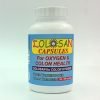Courtesy of www.thepotbook.com
Cannabis in the Ancient World
Chris Bennet
The role of cannabis in the ancient world was manifold, a food, fiber, medicine and as a magically
empowered religious sacrament. In this paper the focus will be on archaic references to cannabis use as
both a medicine and a sacrament, rather than as a source of food or fiber, and it’s role in a variety of
Ancient cultures in this context will be examined.
Unfortunately, due to the deterioration of plant matter archeological evidence is sparse and “Pollen records
are frequently unreliable, due to the difficulty in distinguishing between hemp and hop pollen” (Scott,
Alekseev, Zaitseva, 2004). Despite these difficulties in identification some remains of cannabis fiber,
cannabis beverages utensils, seeds of cannabis and burnt cannabis have been located (burnt cannabis has
been carbonized and this preserves identifiable fragments of the species). Fortunately other avenues of
research regarding the ancient use of cannabis remain open, and etymological evidence regarding cannabis
use in a number of cultures has been widely recognized and accepted.
After nearly a lifetime of research into the role of psychoactive plants in human history the late Harvard
University Professor of ethnobotany, Richard Evans Schultes commented: “Early man experimented with
all plant materials that he could chew and could not have avoided discovering the properties of cannabis
(marijuana), for in his quest for seeds and oil, he certainly ate the sticky tops of the plant. Upon eating
hemp, the euphoric, ecstatic and hallucinatory aspects may have introduced man to the other-worldly plane
from which emerged religious beliefs, perhaps even the concept of deity. The plant became accepted as a
special gift of the gods, a sacred medium for communion with the spiritual world and as such it has
remained in some cultures to the present.”
Not alone in this train of thought, Schultes was joined by the late Carl Sagan who speculated that early man
may have begun the agricultural age by first planting hemp.\
Sagan used the pygmies from southwest
Africa to demonstrate his hypothesis; the pygmies had been basically hunters and gatherers until they began
planting hemp which they used for religious purposes. (Sagan 1977). (The pygmies say they have been
using cannabis since the dawn of time, which more likely means; since the pygmy’s conception of From an essay
Man and Marijuana
Evidence of cannabis use as a fiber goes back 10,000 years.
A view similar to that held by other researchers: Entheobotanist Christian Ratsch writes “No other plant
has been with humans as long as hemp. It is most certainly one of humanity’s oldest cultural objects.
Wherever it was known, it was considered a functional, healing, inebriating, and aphrodisiac plant.
Through the centuries, myths have arisen about this mysterious plant and its divine powers. Entire
generations have revered it as sacred…. The power of hemp has been praised in hymns and
prayers.”(Ratsch 1997).
Pointing out the wide spread religious use of hemp throughout the ancient Near East,
amongst the Babylonians, Assyrians, Scythians and Hebrews, as well as the early spread of its cultic use from
northern Europe, to Siberian Asia, China, India, Asia minor and Southeast Asia, the famed anthropologist
Weston La Barre, suggested that “cannabis was part of a religio-shamanic complex of at least Mesolithic age, in
parallel with an equally old shamanic use of soma…”(La Barre 1980)time
Indeed, as we look at cannabis’ role in a variety of ancient cultures we find this only serves to
strengthen the claims of Sagan and others.
The archeological record documents that stone-age man was not only familiar with cannabis’ fibers, but
also with the effects of burning the plant as well. Oxford archeologist Andrew Sherrat points to the use of
cannabis incenses at a gravesite of a group known as the Proto-Indo-Europeans, the Kurgans, who occupied
what is know Romania 5,000 years ago. The discovery of a smoking-cup which contained remnants of
charred hemp seeds at the site documents that 3,000 years before Christ humanity had already been using
cannabis for religious purposes for millennia. From remnants of the charred hemp seeds we can see that the
combustible (and psychoactive) parts of the plant – namely flowers and leaves – had been consumed and
the hard shell like residue of the seeds left behind. Sherrat also points to even older ceramic tripod bowls,
believed to have been ancient incense burners of cannabis due to the use of hemp cords to place
impressions upon them, as further indications of humanities primordial relationship with cannabis.
It was likely from an even earlier such group that the primordial cannabis cult arose and spread out
reaching all the way from the Orient, throughout the middle east, into Europe, India and Africa.
Considering this it is not surprising to find that the root word for “cannabis” “canna” occurs in the Indo-
European language, the primordial dialect that accounts for similarities in the English, German, Latin,
Greek, Persian and Sanskrit languages. Canna came to refer to the long cane like stocks of the multi-
purpose cannabis crop grown in the ancient world, for both fibrous and pharmacological properties, and the
term cane itself is derived from cana and can originally be identified with the multi-purpose hemp stalk.
Possibly still earlier than the Indo-European use of cannabis, is the role that hemp played in the even more
ancient traditions of the Indigenous people of the Orient.
Cannabis in China
The earliest reference to the use of marijuana as a medicine is believed to have occurred sometime around
2,800 BCE , in the medical compendium, the Pen Ts’aoof the legendary Chinese Emperor Shen-Nung. As
Emperor, Shen-Nung was concerned that the priests were unable to effectively treat the maladies of his
subjects by performing magical rites, and decided to find alternative remedies for the sick. Despite being
emperor, Shen-Nung was apparently also an expert farmer, and had a thorough knowledge of plants. With
this in mind, undoubtedly taken alongside a knowledge of indigenous folk remedies, Shen-Nung decided to
A common effect noticed by novice users of cannabis is a differentiation in the usual experience of time;
i.e., “It seemed like an hour but it was only a minute”, or visa versa. Noticing a difference in the experience
of linear time may well have played a role in the conception and formulation of the idea of time itself.
(Likewise, a deeper awareness of seasonal time may have developed alongside agriculture and the necessity
of keeping track of the growing season). Interestingly, both Father Time and the Grim Reaper hold a
scythe, an ancient tool used for harvesting cannabis and whose imagery and name go back to the Scythian
cult of the Dead, who used hemp for ritual ecstasy. Likewise, the conception of a beginning and end of
time, was conceived of in the cannabis based revelations of the Zoroastrian hero, King Vishtaspa. On a
more nostalgic note; the experience of time differentiation led the 1930’s jazz great, Gene Kupra, to claim
that with cannabis he was able to get drum beats in where it was formerly impossible to, contributing
greatly to jazz drumming. Referring to Kupra’s claim, the horrified father of modern cannabis prohibition,
Henry Anslinger, in his MARIJUANA: ASSASSIN OF YOUTH , commented on the “strange quality of marijuana
which makes a rubber band out of time, stretching it to unbelievable lengths. The musician who uses
‘reefers’ finds that the musical beat seemingly comes to him quite slowly, thus allowing him to interpolate
any number of improvised notes with comparative ease. While under the influence of marijuana, he does
not realize that he is tapping the keys with a furious speed impossible for one in a normal state of mind;
marijuana has stretched out the time of music until a dozen notes may be crowded into the space normally
occupied by one.”(Anslinger 1937). In the ancient world, such an effect contributed immensely to
marijuana’s reputation for containing magical properties.
Although it is widely believed to have originated around this time, no original copies of the text have
survived. The oldest copy of the Pen Ts’ao
dates to about 100 AD, and was compiled by an anonymous
author who claimed to have incorporated the more ancient material into his own medical compendium.
ancient compilers state that Shen-Nung was aided in his studies by having the superman like power of
being able to see through his abdominal wall and into his stomach, enabling the Emperor to observe the
effects of the plants he experimented with on his digestive system!
In the Chinese cosmology, the universe is composed of two elements, the Yang, representing the strong,
active, positive masculine force and Yin, the weak, passive and negative female influence. In the
individual, when these forces are in balance, the body is healthy, but too much of one or not enough of
another and the result is diss-ease. In the case of the application of marijuana to such an ailment, this was
difficult as it had both male and female plants, and contained both yin and yang. Shen-Nung determined
that it was the female plant that contained the most potent medicine, being a very high source of yin, and
prescribed chu-ma, (female hemp, as opposed toma,
emp) for the treatment of absentmindedness,constipation, malaria, beriberi, rheumatism and menstrual problems. The”
Father of Chinese Medicine“,
Shen-Nung, was so thoroughly impressed with the beneficial effects ofchuma , he deemed it one of the
Superior Elixirs of Immortality.
Throughout the centuries, Chinese physicians continued to prescribe marijuana, and as they became more
familiar with the effects of the plant, new discoveries were made about its properties. Such as that made in
200 AD, by the early and well-known Chinese surgeon, Hua T’o. Almost 2,000 years ago Hua T’o is
reputed to have performed such complicated operations as “organ grafts, resectioning of intestines,
laparotomies (incisions into the loin), and thoracotomies (incisions into the chest)” (Abel 1980). Moreover,
these dangerous and complicated surgeries were rendered painless by an anesthetic prepared from cannabis
resin and wine known as
ma-yo
. An excerpt from his biography gives us a descriptive account of how this
ancient medical sage utilized cannabis in these procedures;
“… if the malady resided in the parts on which the needle [acupuncture], cautery, or medicinal liquids were
incapable of acting, for example, in the bones, in the stomach or in the intestine, he administered a
preparation of hemp [ma-yo] and, in the course of several minutes, an insensibility developed as if one had
been plunged into drunkenness or deprived of life. Then, according to the case, he performed the opening,
the incision or amputation and relieved the cause of the malady; then he apposed the tissues by sutures and
applied liniments. After a certain number of days the patient finds he has recovered without having
experienced the slightest pain during the operation.”[As quoted in (Abel 1980)]
Ancient Chinese Shamans showed their awareness of cannabis medical powers symbolically, by carving
serpents into a stalk of hemp and using it as a magic wand for healing ceremonies.
China’s ancient use of cannabis flowers and leaves was not limited to medicine, as ancient Taoist references
record that the herb was also used for mystical purposes as well.” ATaoistpriest wrote in the fifth century B.C. thatCannabis
was employed by “necromancers, in combination with Ginseng, to set forward time
and reveal future events.” In these early periods, use of Cannabis
as an hallucinogen was undoubtedly associated with Chinese shamanism…”Schultes and Hoffman, 1992) . A quatrain from the ancient Chinese
classic ‘Greater Lord of the Long Life’, believed to be written around 300 BC, gives a clear impression of
cannabis’ importance to the mystics of the area and era.
First a yin then a yang
No one knows what I do
Jade buds of holy hemp
for the one who lives apart
In the 2006 Journal of Ethnopharmacology article ‘A new insight into Cannabis sativa (Cannabaceae)
utilization from 2500 year-old Yanghai Tombs, Xinjiang, China’ the authors discuss rare well preserved
archeological specimens of cannabis and conclude that “Based on the shamanistic background of the
As quoted in ‘Road To Heaven: Encounters with Chinese Hermits’, (Porter, 1993)
eceased man and ancient customs, it is assumed that the Cannabis was utilized for ritual/medicinal
purposes.” (Jiang et. al. 2006)
“The deceased, presumably a shaman, may have been mainly concerned with the ritual of communication
between the human and the spirit world. The gift of Cannabis may have been to enable him to continue his
profession in the afterlife. A shaman who knew the utility of herbal medicine also played the role of
physician in ancient times…. . The new discovery of hemp in the Yanghai Tombs, Turpan, China provides
evidence for ancient hemp utilization in Chinese… the hemp was used for medicinal and religious rituals in
NW China…” (Jiang et. al. 2006) India
Not surprisingly, the Chinese were not the only ones to discover the benefits of the healing herb in the
ancient world. The ancient Ayurvedic system of Indian medicine contains a number of references regarding
cannabis. The Ayurveda traces its mythological roots back to gathering of sages in the Himalayas that took
place about 5,0000 years ago. The Sages, who arrived from all areas of the country, exchanged their
knowledge of healing, and this was passed down verbally for some generations until finally being
committed to writing sometime around the first century AD. “Ayurvedic physicians of India use bhang to
treat dozens of diseases and medical problems including diarrhea, epilepsy, delirium and insanity, colic,
rheumatism, gastritis, anorexia, consumption, fistula, nausea, fever, jaundice, bronchitis, leprosy, spleen
disorders, diabetes, cold, anemia, menstrual pain, tuberculosis, elephantiasis, asthma, gout, constipation,
and malaria…”(Robinson 1996).
Later Indian texts such as the Tajni Guntu, the Rajbulubha and the Susruta
list cannabis as a treatment for clearing phlegm, expelling flatulence, inducing costiveness, sharpening memory, increasing eloquence, as
an appetite stimulant, for gonorrhea, and as a general tonic.
Alongside this ancient knowledge of cannabis’ medical values in India there has existed an equally old and
influential role as the plant for sacred and mystical purposes. As noted by
J. M. CAMPBELL a 19th century British Raj COLLECTOR OF LAND REVENUE AND CUSTOMS AND OPIUM in
Bombay in his 1894 essay ON THE RELIGION OF HEMP: [Excerpt from Campbell essay]
To the Hindu the hemp plant is holy. A guardian lives in the bhang leaf… its thought-bracing qualities show
that the bhang leaf is the home of the great Yogi or brooding ascetic Mahadev.
So holy a plant should have special rearing. Shiva explains to his wife, Parvati, how, in sowing hemp seed,
you should keep repeating the spell ‘Bhangi’, ‘Bhangi’, apparently that the sound of that guardian name may
scare the evil tare-sowing influences. Again, when the seedlings are planted the same holy name must be
repeated, and also at the watering which, for the space of a year, the young plants must daily receive. When
the flowers appear the flowers and leaves should be stripped from the plant and kept for a day in warm
water. Next day, with one hundred repetitions of the holy name Bhangi, the leaves and flowers should be
washed in a river and dried in an open shed. When they are dry some of the leaves should be burnt with due
repeating of the holy name as ajapor muttered charm. Then, bearing in mind Vagdevata, or the goddess of
speech, and offering a prayer, the dried leaves should be laid in a pure and sanctified place. Bhang so
prepared, especially If prayers are said over it, will gratify the wishes and desires of its owner. Taken in the
early morning such bhang cleanses the user from sin, frees him from the punishment of crores of sins, and
entitles him to reap the fruits of a thousand horse-sacrifices. Such sanctified bhang taken at day break or noon
destroys disease. Before the religious user of bhang stand the Ashtadevata or Eight Guardians with
clasped hands ready to obey him and perform his orders. The wish of him who with pure mind pours bhang
with due reverence over the Ling of Mahadev will be fulfilled.
…. To meet some one carrying bhang is a sure omen of success. To see in a dream the leaves, plant, or
water of bhang is lucky; it brings the goddess of wealth into the dreamer’s power. To see his parents
worship the bhang-plant and pour bhang over Shiva’s Ling will cure the dreamer of fever. A longing for
bhang foretells happiness: to see bhang drunk increases riches. No good thing can come to the man who
treads under foot the holy bhang leaf.
… In the ecstasy of bhang the spark of the Eternal in man turns into light the murkiness of matter or
illusion and self is lost in the central soul-fire. The Hindu poet of Shiva, the Great Spirit that living in bhang
passes into the drinker, sings of bhang as the clearer of ignorance, the giver of ‘knowledge. No gem or jewel
can touch in value bhang taken truly and reverently. He who drinks bhang drinks Shiva. The soul in whom
the spirit of bhang finds a home glides into the ocean of Being freed from the weary round of matter-
blinded self. To the meaner man, still under the glamour of matter or maya, bhang taken religiously is
kindly thwarting the wiles of his foes and giving the drinker wealth and promptness of mind.
… To its devotee bhang is no ordinary plant that became , holy from its guardian and healing qualities.
According to one account, when nectar was produced from the churning of the ocean, something was
wanted to purify the nectar. The deity supplied the want of a nectar-cleanser by creating bhang. This bhang
Mahadev made from his own body, and so it is calledangaj or body-born. According to another account
some nectar dropped to the ground and from the ground the bhang plant sprang. It was because they used
this child of nectar or of Mahadev in agreement with religious forms that thee seers or Hishis became
Siddha or one with the deity. He who, despite the example of the Hishis, uses no bhang shall lose his
happiness in this life and in the life to come. In the end he shall be cast into hell. The mere sight of bhang,
cleanses from as much sin as a thousand horse-sacrifices or a thousand pilgrimages. He who scandalizes the
user of bhang shall suffer the torments of hell so long as the sun endures. He who drinks bhang foolishly or
for pleasure without religious rites is as guilty as the sinner of lakhs of sins. He who drinks wisely and
according to rule, be he ever so low, even though his body is smeared with human ordure and urine, is
Shiva. No god or man is as good as the religious drinker of bhang. The students of the scriptures at Benares
are given bhang before they sit to study. At Benares, Ujjain, and other holy places yogis, bairagis and
sanyasis take deep draughts of bhang that they may Centre their thoughts on the Eternal… To forbid or
even seriously to restrict the use of so holy and gracious a herb as the hemp would cause widespread
suffering and annoyance and to the large bands of worshipped ascetics deep-seated anger… Bhang brings
union with the Divine Spirit. ‘We drank bhang and the mystery I am He grew plain. So grand a result, so
tiny a sin.”
End Campbell essay Ancient Mid-East
It is widely believed that cannabis was brought to the mid-east by Caucasian tribes that lived on the borders
between what is now Russia and China. Likely these tribes, now know under the collective title of the
Scythians, took to their use of cannabis, from the same Oriental tribes that pushed them out of their
homeland.
The Scythians played a very important part in the Ancient World from the seventh to first century BC. They
were expert horsemen, and were one of the earliest peoples to master the art of riding and using horse-
drawn covered wagons. This early high mobility is probably why most scholars credit them with the spread
of cannabis knowledge throughout the ancient world. Indeed, the Scythian people travelled and settled
extensively throughout Europe, the Mediterranean, Central Asia, and Russia, bringing their knowledge of
the spiritual and practical uses for cannabis with them.
Marijuana was an integral part of the Scythian cult of the dead wherein homage was paid to the memory of
their departed leaders. In a famous passage written in about 450 B.C., Herodotus describes the funeral rites
See also ‘On References to the hemp Plant Occurring in Sanskrit and Hindi Literature, (1893), by G.A.
Grierson, reprinted in
THE CONNOISSEUR’S HANDBOOK OF MARIJUANA, (Drake, 1971)
Research, we were able to follow the history of the sacred anointing oil into the early Christian period,
particularly amongst heretical Gnostic Christian sects, that along with pagan cults, were brutally banned at
the inception of the Dark Ages and the rise of Catholicism.
As noted the term ‘Christ’ itself is Greek rendering of the Hebrew ‘Messiah’ and this means the ‘anointed
one’ making reference back to the original anointing oil as described in Exodus 30:23 . Indeed even in the
New Testament Jesus does not baptize any of his own disciples, but rather in the oldest of the synoptic
Gospels Jesus sends out his followers to heal with the anointing oil “they cast out many devils, and a
anointed with oil many that were sick, and healed
them.” (Mark 6:13)
Likewise, after Jesus’ passing,
James suggests that anyone of the Christian community who was sick should call to the elders to anoint
him with oil in the name of Jesus (James 5:14). “
Is any one of you sick? He should call the elders of the
church to pray over him and anoint him with oil in the name of the Lord.”
It should also be understood that in the ancient world, diseases such as epilepsy were attributed to demonic
possession, and to cure somebody of such an illness, even with the aid of certain herbs, was the same as
exorcism, or miraculously healing them. Interestingly, cannabis has been shown to be effective in the
treatment of not only epilepsy, but many of the other ailments that Jesus and the disciples healed people of,
such as skin diseases (Matthew 8, 10, 11; Mark 1; Luke 5, 7, 17), eye problems (John 9:6-15), and
menstrual problems (Luke 8:43-48).
According to ancient Christian documents, even the healing of cripples could be attributed to the use of the
holy oil. “Thou holy oil given unto us for sanctification… thou art the straightener of the crooked limbs”
(The Acts of Thomas).
One ancient Christian text, The Acts of Peter and the Twelve Apostles, which is older than the New
Testament, estimated to have been recorded in the second century AD, has Jesus giving the disciples an
“unguent box” and a “pouch full of medicine” with instructions for them to go into the city and heal the
sick. Jesus explains that you must heal “the bodies first” before you can “heal the heart.”
As Jesus and his followers began to spread the healing knowledge of cannabis around the ancient world,
the singular Christ became the plural term “Christians,” that is, those who had been smeared or anointed
with the holy oil. As the New Testament explains: “The anointing you received from him remains in you,
and you do not need anyone to teach you. But as his anointing teaches you about all things and as that
anointing is real, not counterfeit—just as it has taught you, remain in him” (1 John 2:27).
The Christians, the “smeared or anointed ones,” received “knowledge of all things” by this “anointing from
the Holy One” (1 John 2:20). Thereafter, they needed no other teacher, and were endowed with their own
spiritual knowledge.
“Residues of cannabis, moreover, have been detected in vessels from Judea and Egypt
in a context indicating its medicinal, as well as visionary, use.”(Ruck 2003)
A archeological dig in Bet Shemesh near Jerusalem has confirmed that cannabis medicine was in use in
the area up until the fourth century. Thus it would seem to stand to reason that it was used for these
purposes throughout the intervening Christian period. In the case of the Bet Shemesh dig, the cannabis had
been used as an aid in child bearing, both as a healing balm and an inhalant. Scientists commenting on the
find noted that cannabis was used as a medicine as early as the 16th century BC, in Egypt.
(Abel 1980)
Thisfind garnered some attention, as can be seen from the Associated Press article, “Hashish evidence is 1,600
years old”, that appeared in Vancouver newspaper The Province, on June 2, 1992:
”Archaeologists have found hard evidence that hashish was used as a medicine 1,600 years ago, the Israel
Antiquities Authority said yesterday.
Archaeologists uncovered organic remains of a substance containing hashish, grasses and fruit on the
abdominal area of a teenage female’s skeleton that dates back to the fourth century, the antiquities
authority said in a statement.
Anthropologist Joel Zias said that although researchers knew hashish had been used as a medicine, this is
the first archeological evidence.” (Associated Press 1992).
In the first few centuries AD, Christian Gnostic groups such as the Archontics, Valentians and Sethians
rejected water baptism as superfluous, referring to it as an “incomplete baptism”.( The Paraphrase of
Shem. )In the tractate, the Testimony of Truth, water Baptism is rejected with a reference to the fact that
Jesus baptized none of his disciples.(Rudolph, 1987) Being “anointed with unutterable anointing”, the so-
called “sealings” recorded in the Gnostic texts, can be seen as a very literal event. “There is water in water,
there is fire in chrism.” (Gospel of Philip). “The anointing with oil was the introduction of the candidate
into unfading bliss, thus becoming a Christ.” (Mead, 1900) “The oil as a sign of the gift of the Spirit was
quite natural within a semetic framework, and therefore the ceremony is probably very early. . . In time the
biblical meaning became obscured.” (Chadwick, 1967)
The surviving Gnostic descriptions of the effects of the anointing rite make it very clear that the holy oil
had intense psycho-active properties, which prepared the recipient for entrance into “unfading bliss”. In
some Gnostic texts like the Pistis Sophia and the Books of Jeu, the “spiritual ointment” is a prerequisite for
entry into the highest mystery. (Mead, 1900)
In the Gospel of Philip it is written that the initiates of the empty rite of Baptism:
“go down into the water and come up without having received anything. . . The anointing (chrisma) is
superior to baptism. For from the anointing we were called ‘anointed ones’ (Christians), not because of the
baptism. And Christ also was [so] named because of the anointing, for the Father anointed the son, and the
son anointed the apostles, and the apostles anointed us. [Therefore] he who has been anointed has the All.
He has the resurrection, the light. . . the Holy Spirit. . . [If] one receives this unction, this person is no
longer a Christian but a Christ.”
Similarly, the Gospel of Truth records that Jesus specifically came into their midst so that he:
“might anoint them with the ointment. The ointment is the mercy of the Father. . . those whom he has
anointed are the ones who have become perfect.”
The apocryphal book, The Acts of Thomas, refers to the ointment’s entheogenic effects as being specifically
derived from a certain plant:
Holy oil, given us for sanctification, hidden mystery in which the cross was shown us, you are the unfolder
of the hidden parts. You are the humiliator of stubborn deeds. You are the one who shows the hidden
treasures. You are the plant of kindness. Let your power come by this [unction].
Although the idea that Jesus and his disciples used a healing cannabis ointment may seem far-fetched at
first, when weighed against the popular alternative (one that is held by millions of believers) that Jesus
performed his healing miracles magically, through the power invested in him by the omnipotent Lord of the
Universe, the case for ancient accounts of medicinal cannabis seems a far more likely explanation. When
one considers that Jesus himself may have healed and initiated disciples with such topical cannabis
preparations, the modern reintroduction of cannabis based medicines becomes, if not a miracle, at least a
profound revelation..
In light of this profound history, some have come to see the use of cannabis as a freedom of religion issue.
But after 15 years of researching the cross-cultural history of cannabis, and following it’s use from the
stone age to present, I have come to see that the right to cannabis is even more fundamental than religious
freedoms, for humanity created religion, but no matter what god you believe in, you had better believe that
god created cannabis. Even from an atheistic standpoint, from the cross cultural perspective, as possibly our
oldest cultivated crop, humanity has had a evolutionary partnership with this plant that stretches back more
than 10,000 years. Indeed humanity has a natural indigenous right to all the plants of the earth, all people
and all plants, any law that stands in the way of that natural relationship is an abomination to both God and
Nature.
Preservation is an issue that must be addressed, as extinction of a species threatens our collective
inheritance, endangered species must be protected for the benefit of all.






